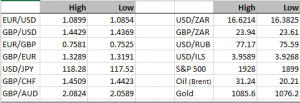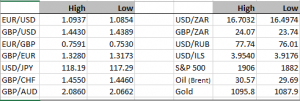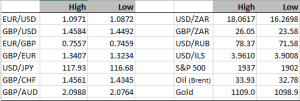The Bank of England’s monetary policy (MPC) meeting yesterday reconfirmed the banks gloomy outlook for the UK economy and voted to keep rates on hold. Not the biggest shock, no one expected anything different. There was a great deal of interest in whether the composition of votes would change as there has been one solitary hawk for the last few months, and some speculated that if he capitulated that might be quite negative for sterling. As it happened the voting pattern was unchanged with 8 voting to keep rates on hold, and the hawk stubbornly voting for a 25bps hike. The MPC did observe that the outlook has deteriorated since the November meeting, and the market has unsurprisingly continued to push further out the time for the first rate hike to 2017. The minutes suggest that falling oil prices have reduced any inflation threat and that the housing market remains relatively subdued. There was some weakening of sterling before the announcement although there was a little bit of a recovery afterwards, this has only accelerated this morning with GBP/USD approaching multi-decade lows again. As we’ve stated in recent blogs we continue to believe that there is scope for further sterling weakness with GBP/USD capable of moving below 1.40 in the near term. This is certainly not a time to go on a shopping trip to the US if you live in the UK!
The ECB also published the minutes of their December meeting in which it becomes clear that some voters did push for more stimulus which would have been more in line with market expectations, however there was too much opposition and the more conservative approach won out. What I did find interesting though, is that there does appear to be some wiggle room to re-assess that decision, which means that we can’t fully discount more aggressive QE in 2016. Whether it happens or not, it is the markets ability to speculate/hope that such a decision might be made which would be most impactful on the euro. But at the moment there doesn’t seem to be even the remotest sniff of that as the euro actually looks fairly stable versus the dollar.
The currency devastation continues for developing economy oil exporters. In December South Sudan and then Azerbaijan abandoned their pegs to the dollar resulting in 85% and 32% plunges for their currencies respectively. Earlier this week the Angolan kwanza fell 15% to a record low versus the dollar as the central bank devalued the currency on the back of slumping revenues accrued from crude oil production. These moves in my view are entirely sensible considering the huge decline in revenues over the last 18 months. When you put it into this context the panic in the Nigerian currency market is understandable, particularly when you realise that the official naira exchange rate has not fallen anywhere near the extent of the aforementioned currencies. And that’s without me mentioning the likes Russia and Venezuela. This is why when I suggest that the official USD/NGN rate staying at 199 is simply unsustainable. Yesterday we saw offers to sell naira above 300 for the first time. I suggest we get comfortable with the new big figure. Unless you believe the oil price is going to start rallying from here it’s hard to see a justification for a reversal of the naira’s fortunes. In the Financial Times recently external experts are already speculating that the Nigerian government has already decided to devalue the official rate and that news might come as early as later this month at the next monetary policy announcement. They suggest a move of the band to the 240 – 250 level. A step in the right direction for sure…
It’s been a rough start for the equity markets today with most down anywhere from 1 – 2%. Admittedly this is following on from decent recoveries yesterday. It’s too early to suggest that the market is basing, more likely we are seeing a consolidation which will precede a final push lower. I am certainly not willing to get too bearish at this point. As we’ve pointed out many times in the past, there are positives from falling oil prices, but these take a bit longer to become evident.
DISCLAIMER
Any financial promotion contained herein has been issued and approved by ParityFX Plc (“ParityFX”); a firm authorised and regulated by the Financial Conduct Authority (“FCA”) as a Payment Services Institution with registration number 606416. It is for informational purposes and is not an official confirmation of terms. It is not guaranteed as to accuracy, nor is it a complete statement of the financial products or markets referred to.
Opinions expressed are subject to change without notice and may differ or be contrary to the opinions or recommendations of ParityFX. Unless stated specifically otherwise, this is not a recommendation, offer or solicitation to buy or sell and any prices or quotations contained herein are indicative only. To the extent permitted by law, ParityFX does not accept any liability arising from the use of this communication.
Follow our tweets @parityfxplc
Follow us on LinkedIn ParityFX Plc



